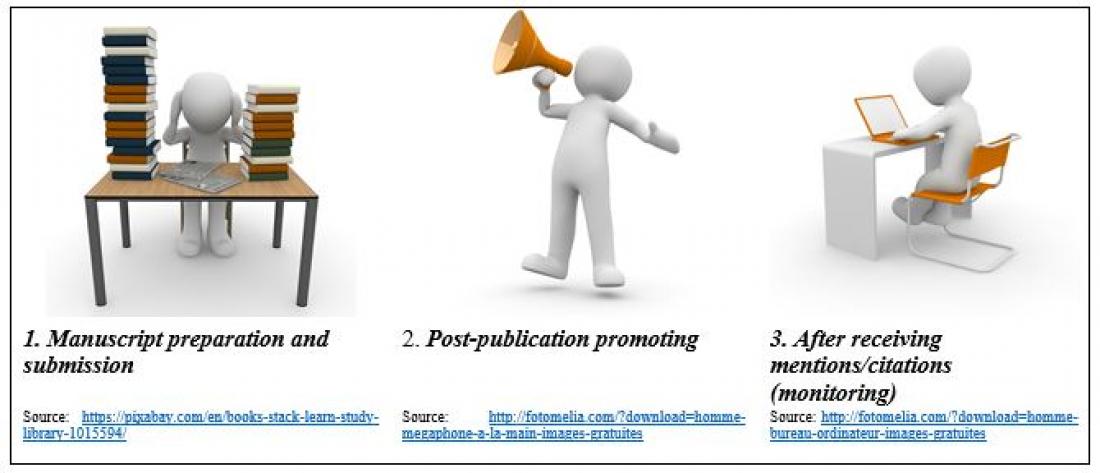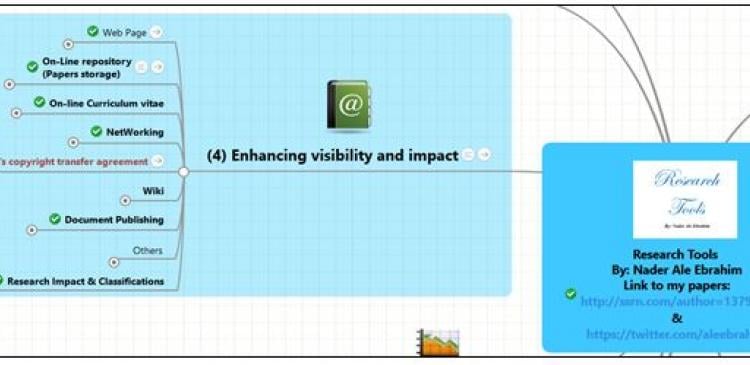Millions of research papers are published yearly by different
journals and indexed in databases such as Web of Science (WoS) and
SCOPUS. However, over 43% of WoS indexed documents have never received
any citations [1]. Publishing a high quality paper in scientific
journals does not guarantee a high citation but just a beginning of the
paper journey. Similarly, the most cited work might not necessary be the
best produced by a researcher [2]. The rest of the paper journey is
still dependent on the dissemination of research findings.
Researchers who authored the research papers are undoubtedly the best
person to promote their own research. With the increasing number of
publications every year, it is important for researchers to know how to
promote their research to maximum effect. A total of 33 strategies have
been listed for increasing the citation possibilities [3]. This article
proposes three stages of the paper journey for promoting research
outputs to maximize research impact and visibility (Figure 1).
Stage (1) - Manuscript preparation and submission
Manuscript should be prepared and written in a search-engine friendly
way [4], especially the title, abstracts, keywords and headings. Most
researchers use specific terms which are only known by peers in their
own fields. The chosen terms need to be commonly used and general to be
optimized and pick up by search-engine in the digital platform.
In addition, name variation and affiliation should be consistent. It
is quite common to share similar names with other researchers. As such, a
unique identifier such as Open Researcher Contribution ID (ORCID; https://orcid.org/) is highly recommended. The ORCID will distinguish researcher and his/her research work from others who has similar name [5].
Future impact is also influenced by the type of paper, with
literature review papers more likely cited as than the original research
papers. Researcher should cite the best references to be the best in
the field [6]. Furthermore, researchers are encouraged to collaborate
internationally for multidisciplinary papers and submit in high rank
journals, such as Nature and Science. The writing style plays an
important role on the future research impact and citations, for an
example, the narrative style of writing may receive more attention
compared to other styles [7].
Stage (2) - Post-publication promoting
Researchers usually stop “the paper journey” after receiving
acceptance from the journal editor. Most researchers only conceptualize
an idea, write the paper, reply reviewers comment, and publish the
article. Research life cycle does not end with just paper submission and
publication. The paper journey continues by dissemination and sharing
the paper to increase readership and make it more visible to the border
range of audiences. Social media such as Twitter, Facebook, LinkedIn and
Academia.edu should be used effectively to promote a research work.
Research findings can be disseminated through academic blogs, news
magazines or even online profile such as Google Scholar and
ResearcherID.
Scientific journals has been moving towards open access, and more
than 50% of new research is now made available free online [8]. Articles
published in Open Access journals tend to be more widely read and cited
than the articles published in traditional subscription-based journals
[9]. Journal papers should be deposited with the open access version
shared through institutional or other repositories such as: SSRN (https://www.ssrn.com/), Arxiv (https://arxiv.org/), Figshare (https://figshare.com/), and ZENODO (https://zenodo.org/). Supplementary files such as data, presentations, video, reports, extra figures and tables can be made available too.
Email marketing is another powerful tool for promoting research.
Latest publications can be emailed to peers besides adding paper link in
email signature. These links comprise all online platforms including
Pinterest, Instagram, Google+ and Snapchat which are usually visited by
peers.
Stage (3) - After receiving mentions/citations (monitoring)
Researchers should monitor their publication impact and find the most
effective channel for promotion. Most of the academic social networks
have analytical tools which allow the researcher to measure each post
traffics. Researcher can measure their immediate research impact by
using Altmetric [10]. Citations is able to be tracked and traced via
alert system in different academic databases and Google Scholar.
Expansion of collaboration is possible by sending invitations to those
who have cited the researchers’ work to join their network in LinkedIn,
Academia, ResearchGate, and Twitter. Thus, researchers are encouraged to
inform peers who cited their papers about their recent research work
and publications by sharing the links. Furthermore, researchers should
create and maintain a scientific track record database highlighting
their academic achievement such as publications in top-ranked journals,
scientific awards, prestigious research grants and others [9].
Conclusion
Research impact is important for researchers to improve their research
reputation, increase university ranking, and getting grants from
funders. As such, dissemination of research findings plays a vital role.
These three stages will help researchers to publicize their research
output and hence increase their visibility. Further links to effective
tools are available online at http://www.mindmeister.com/39583892/research-tools-by-nader-ale-ebrahim part four “Enhancing Visibility and Impact” (Figure 2).
Contact:
Dr. Bong Yii Bonn and Dr. Nader Ale Ebrahim
Centre for Research Services, Institute of Research Management & Services, University of Malaya,
50603 Kuala Lumpur, Malaysia
Correspondence email: yiibonn@um.edu.my / aleebrahim@um.edu.my






